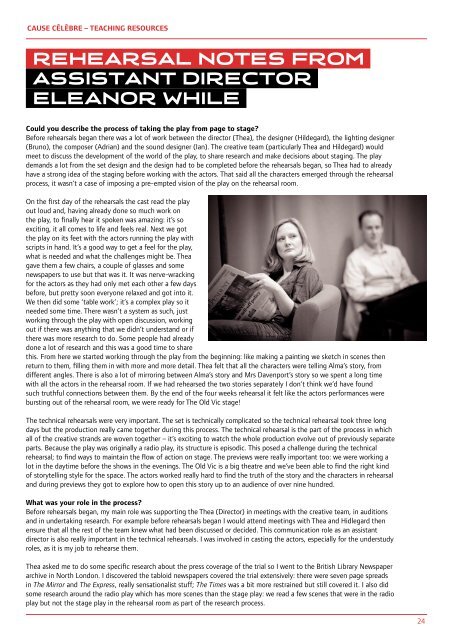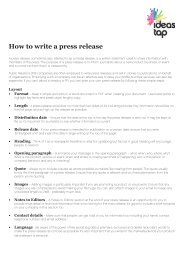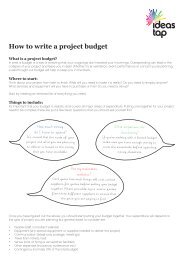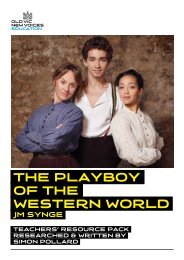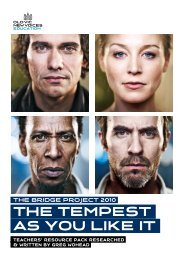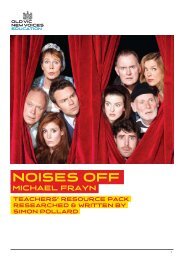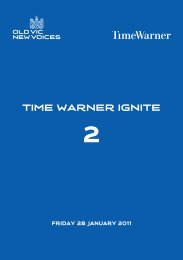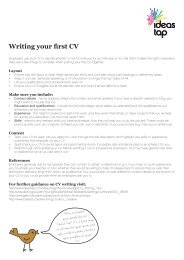Cause Celebre - IdeasTap
Cause Celebre - IdeasTap
Cause Celebre - IdeasTap
You also want an ePaper? Increase the reach of your titles
YUMPU automatically turns print PDFs into web optimized ePapers that Google loves.
CAUSE CélèBRE – TEACHINg RESOURCES<br />
Rehearsal Notes from<br />
Assistant Director<br />
Eleanor While<br />
Could you describe the process of taking the play from page to stage?<br />
Before rehearsals began there was a lot of work between the director (Thea), the designer (Hildegard), the lighting designer<br />
(Bruno), the composer (Adrian) and the sound designer (Ian). The creative team (particularly Thea and Hildegard) would<br />
meet to discuss the development of the world of the play, to share research and make decisions about staging. The play<br />
demands a lot from the set design and the design had to be completed before the rehearsals began, so Thea had to already<br />
have a strong idea of the staging before working with the actors. That said all the characters emerged through the rehearsal<br />
process, it wasn’t a case of imposing a pre-empted vision of the play on the rehearsal room.<br />
On the first day of the rehearsals the cast read the play<br />
out loud and, having already done so much work on<br />
the play, to finally hear it spoken was amazing: it’s so<br />
exciting, it all comes to life and feels real. Next we got<br />
the play on its feet with the actors running the play with<br />
scripts in hand. It’s a good way to get a feel for the play,<br />
what is needed and what the challenges might be. Thea<br />
gave them a few chairs, a couple of glasses and some<br />
newspapers to use but that was it. It was nerve-wracking<br />
for the actors as they had only met each other a few days<br />
before, but pretty soon everyone relaxed and got into it.<br />
We then did some ‘table work’; it’s a complex play so it<br />
needed some time. There wasn’t a system as such, just<br />
working through the play with open discussion, working<br />
out if there was anything that we didn’t understand or if<br />
there was more research to do. Some people had already<br />
done a lot of research and this was a good time to share<br />
this. From here we started working through the play from the beginning: like making a painting we sketch in scenes then<br />
return to them, filling them in with more and more detail. Thea felt that all the characters were telling Alma’s story, from<br />
different angles. There is also a lot of mirroring between Alma’s story and Mrs Davenport’s story so we spent a long time<br />
with all the actors in the rehearsal room. If we had rehearsed the two stories separately I don’t think we’d have found<br />
such truthful connections between them. By the end of the four weeks rehearsal it felt like the actors performances were<br />
bursting out of the rehearsal room, we were ready for The Old Vic stage!<br />
The technical rehearsals were very important. The set is technically complicated so the technical rehearsal took three long<br />
days but the production really came together during this process. The technical rehearsal is the part of the process in which<br />
all of the creative strands are woven together – it’s exciting to watch the whole production evolve out of previously separate<br />
parts. Because the play was originally a radio play, its structure is episodic. This posed a challenge during the technical<br />
rehearsal; to find ways to maintain the flow of action on stage. The previews were really important too: we were working a<br />
lot in the daytime before the shows in the evenings. The Old Vic is a big theatre and we’ve been able to find the right kind<br />
of storytelling style for the space. The actors worked really hard to find the truth of the story and the characters in rehearsal<br />
and during previews they got to explore how to open this story up to an audience of over nine hundred.<br />
What was your role in the process?<br />
Before rehearsals began, my main role was supporting the Thea (Director) in meetings with the creative team, in auditions<br />
and in undertaking research. For example before rehearsals began I would attend meetings with Thea and Hidlegard then<br />
ensure that all the rest of the team knew what had been discussed or decided. This communication role as an assistant<br />
director is also really important in the technical rehearsals. I was involved in casting the actors, especially for the understudy<br />
roles, as it is my job to rehearse them.<br />
Thea asked me to do some specific research about the press coverage of the trial so I went to the British Library Newspaper<br />
archive in North London. I discovered the tabloid newspapers covered the trial extensively: there were seven page spreads<br />
in The Mirror and The Express, really sensationalist stuff; The Times was a bit more restrained but still covered it. I also did<br />
some research around the radio play which has more scenes than the stage play: we read a few scenes that were in the radio<br />
play but not the stage play in the rehearsal room as part of the research process.<br />
24


